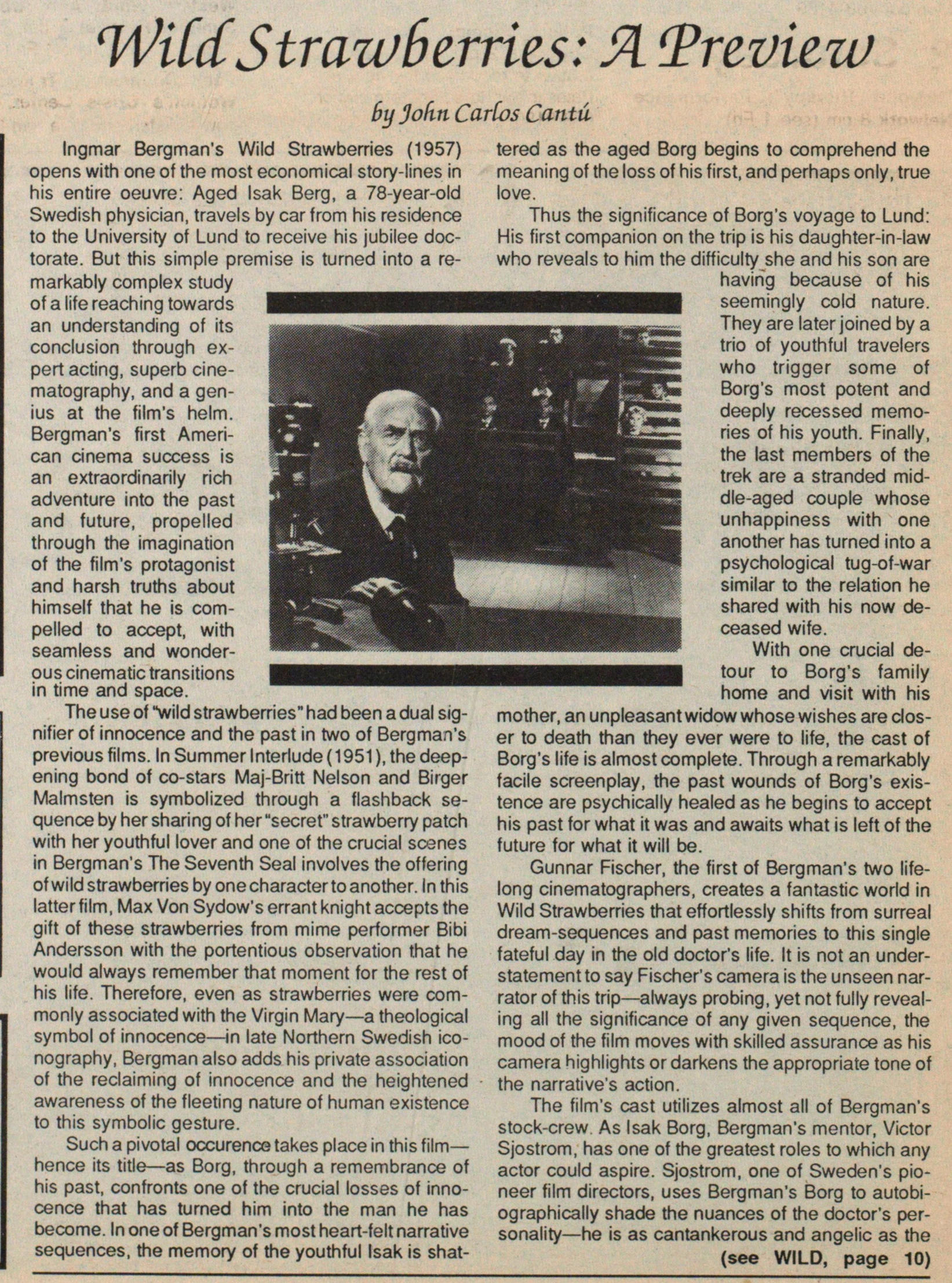Wild Strawberries: A Preview


Ingmar Bergman's Wild Strawberries (1957) opens with one of the most economical story-lines n his entire oeuvre: Aged Isak Berg, a 78-year-old Swedish physician, travels by car from his residence to the University of Lund to receive his jubilee doctorate. But this simple premise is turned into a markably complex study of a life reaching towards an understanding of its conclusion through expert acting, superb cinematography, and a genius at the film's helm. Bergman's first American cinema success s an extraordinarily rich adventure into the past and future, propelled through the imagination of the film's protagonist and harsh truths about himself that he is compelled to accept, with seamless and wonderous cinematic transitions in time and space.
The use of "wild strawberries" had been a dual signifier of innocence and the past in two of Bergman's previous films. In Summer Interlude (1951), the deepening bond of co-stars Maj-Britt Nelson and Birger Malmsten is symbolized through a flashback sequence by her sharing of her "secret" strawberry patch with her youthful lover and one of the crucial scènes in Bergman's The Seventh Seal involves the offering of wild strawberries by one character to another. In this latter film , Max Von Sydow's errant knight accepts the gift of these strawberries from mime performer Bibi Andersson with the portentious observation that he would always remember that moment for the rest of his life. Therefore, even as strawberries were commonly associated with the Virgin Mary - a theological symbol of innocence- in late Northern Swedish iconography, Bergman also adds his private association of the reclaiming of innocence and the heightened awareness of the fleeting nature of human existence to this symbolic gesture.
Such a pivotal occurence takes place in this film - hence its title- as Borg, through a remembrance of his past, confronts one of the crucial losses of innocence that has turned him into the man he has become. In one of Bergman's most heart-felt narrative sequences, the memory of the youthful Isak is shattered as the aged Borg begins to comprehend the meaning of the loss of his first, and perhaps only, true love.
Thus the significance of Borg's voyage to Lund: His first companion on the trip is his daughter-in-law who reveals to him the difficulty she and his son are having because of his seemingly cold nature. They are later joined by a trio of youthful travelers who trigger some of Borg's most potent and deeply recessed memories of his youth. Finally, the last members of the trek are a stranded middle-aged couple whose unhappiness with one another has turned into a psychological tug-of-war similar to the relation he shared with his now deceased wife.
With one crucial detour to Borg's family home and visit with his mother, an unpleasant widow whose wishes are closer to death than they ever were to life, the cast of Borg's life is almost complete. Through a remarkably facile screenplay, the past wounds of Borg's existence are psychically healed as he begins to accept his past for what it was and awaits what is left of the future for what it will be.
Gunnar Fischer, the first of Bergman's two lifelong cinematographers, creates a fantastic world in Wild Strawberries that effortlessly shifts from surreal dream-sequences and past memories to this single fateful day in the old doctor's life. It is not an understatement to say Fischer's camera is the unseen narrator of this trip- always probing, yet not fully revealing all the significance of any given sequence, the mood of the film moves with skilled assurance as his camera highlights or darkens the appropriate tone of the narrative's action.
The film's cast utilizes almost all of Bergman's stock-crew As Isak Borg, Bergman's mentor, Victor Sjostrom, has one of the greatest roles to which any actor could aspire. Sjostrom, one of Sweden's pioneer film directors, uses Bergman's Borg to autobiographically shade the nuances of the doctor's personality - he is as cantankerous and angelic as the
(see WILD, page 10)
WILD (from page 6) script calls tor. One of Bergman's most beautiful ding ladies, Ingrid Thulin, captures the resignation and youthful hope for a better tomorrow as Borgs daughter-in-law, Marianne. Gunnar Bjornstrand and Maima Wifstrand- both pivotal mainstays of Bergmans Smiles of a Summer Night (1955)- expertly play the staid, repressed, and unhappily bourgeois son and mother of Borg White rounding out the main characters of the cast is Bibi Andersson in the crucial dual roles of the multi-dimensional Sara- one, Borg's past love, and the other, his present youthful companion- with a smile that conveys a brightness that compensates for the accumulative pain in Borg's adult life.
But the real star of Wild Strawberries s Ingmar Bergman. Through his screenplay and directorial guidance, one of the most affirmative films about lite and living unfolds before the viewer's eyes. And like all life, there is a tremendous amount of suffering that must be compensated before a growing awareness of the vitality of living itself can take place. It is Bergman's greatest feat to teach us of the value of remaining faithful to ourselves through the minute gestures of everyday life. It is truly his "wild strawberries" that carries the bittersweet burdens of our joys and disappointments.
Wild Strawberries will be shown on Sat., July 16, at 7:30 and 9:30 pm in the U-M Modern Languages Building, Aud. 4.